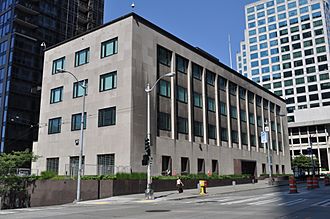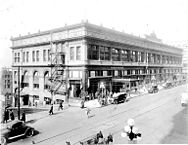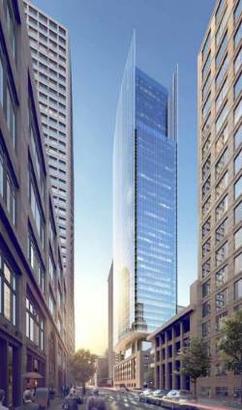Federal Reserve Bank Building (Seattle) facts for kids
Quick facts for kids Federal Reserve Bank Building |
|
|---|---|

Looking northwest from Madison Street, 2009
|
|
| Alternative names | Federal Reserve Bank of San Francisco, Seattle Branch |
| General information | |
| Status | Complete |
| Type | Bank branch |
| Architectural style | Modernist |
| Address | 1015 2nd Avenue Seattle, Washington |
| Groundbreaking | April 20, 1950 |
| Completed | 1950 |
| Opened | January 2, 1951 |
| Closed | February 20, 2008 |
| Client | Federal Reserve Bank of San Francisco |
| Owner | Martin Selig Real Estate |
| Technical details | |
| Structural system | Steel |
| Material | Reinforced concrete |
| Floor count | 6 |
| Floor area | 119,452 sq ft (11,097.5 m2) |
| Grounds | 25,920 sq ft (2,408 m2) |
| Design and construction | |
| Architect | William J. Bain |
| Architecture firm | NBBJ |
| Main contractor | Kuney Johnson Company |
|
Federal Reserve Bank of San Francisco, Seattle Branch
|
|
| Location | Seattle, Washington |
| Built | 1950 |
| Architect | Naramore, Bain, Brady & Johanson |
| Architectural style | Modernist |
| NRHP reference No. | 11000985 |
| Added to NRHP | February 4, 2013 |
The Federal Reserve Bank Building in Seattle, also known as the Federal Reserve Bank of San Francisco, Seattle Branch, was once a very important bank office. It served as the Seattle branch of the Federal Reserve Bank of San Francisco for over 50 years, from 1951 to 2008.
After the bank moved out, there were many ideas for what to do with the building. One plan was to tear it down, but a court stopped that from happening. In 2013, the building became part of the National Register of Historic Places, which means it's recognized as an important historical site. In 2015, a company called Martin Selig Real Estate bought the building. They first planned to build a very tall skyscraper on top of it, but later decided to build a smaller addition of only seven floors.
Contents
What Does the Building Look Like?
The Federal Reserve Bank Building is a Modernist style building. It has six stories, with four above the street and two below. It is made from strong materials like steel and reinforced concrete.
Exterior Design and Features
The front of the building, facing 2nd Avenue, is covered with light gray limestone. The walls of the basement are made of reddish-brown granite. In front of the main entrance, there is a small open area with planters made of polished granite. This area is set back from the street, making a welcoming space.
Inside the Bank Building
The two floors underground held a very large bank vault. This vault was built with thick reinforced concrete walls and strong stainless steel doors. It was designed to be very secure. These basement floors also had a small parking garage and a secure area for trucks. There was even a shooting range for the security team to practice.
The first floor was the only part of the building open to the public. It had the main lobby and places where bank tellers used to help customers. A small space on this floor was once used by the Federal Bureau of Investigation (FBI) in the 1950s. The upper floors were mostly open offices and areas for processing checks. They also had places for employees to relax, like a cafeteria and lounges.
Who Designed the Building?
The Federal Reserve Bank Building was designed by a Seattle company called NBBJ. This company is very famous for its architecture. The main architect for this project was William J. Bain. The building was made to be very strong, even able to withstand an atomic bomb blast. It was also updated later to be resistant to strong earthquakes. Its design looks very solid and simple, showing strength and security.
History of the Building
The Seattle branch of the Federal Reserve Bank first opened in 1917. For about 30 years, it rented space in another building in downtown Seattle called the Baillargeon Building.
Building a New Home
In 1948, plans were made to build a new, permanent home for the bank. The chosen spot was at 2nd Avenue and Madison Street. This location was perfect because it was close to Seattle's main financial area. To build the new bank, an older building called the Rialto Building was torn down. The Rialto Building had once been home to the Seattle Public Library and one of the first Frederick and Nelson department stores.
The new six-story building was designed by NBBJ. It was built with a steel frame and cost about $2.5 million in 1950. Construction began on April 20, 1950, and took nine months to complete. The Federal Reserve Bank Building officially opened on January 2, 1951. For a while, the Federal Bureau of Investigation (FBI) also shared space in the new building.
Changes Over the Years
Over its 50 years of use, the building had some small changes and updates. In 1958, the outside of the building was cleaned and waterproofed. In the 1980s, the roof and windows were replaced. In the 1990s, parts of the building were updated to add new areas for employees, like a cafeteria and meeting rooms.
When the 2001 Nisqually earthquake happened in 2001, the building only had minor damage. This was because it had been strengthened in 1996 to better withstand earthquakes. After the September 11, 2001 attacks, the building was closed to the public. More security features were added around it to keep it safe.
Moving to a New Location
In 2004, the Federal Reserve announced that its Seattle branch would move to a new location in Renton, Washington. The old Seattle building closed on February 20, 2008. Bank officials said the old building was "no longer adequate" and didn't meet the new security rules after 2001. In 2012, the building was given to the General Services Administration (GSA) to prepare it for sale.
What Happened to the Building Next?
After the bank moved out in 2008, a company tried to buy the building. However, groups who wanted to protect historic buildings disagreed. They went to court to stop the sale. In 2010, a judge ruled that the Federal Reserve Bank had not followed the correct rules for selling government property. This stopped the sale.
Becoming a Historic Place
On February 4, 2013, the Federal Reserve Bank Building was officially added to the National Register of Historic Places. This means it is now protected as an important historical site.
Auction and New Plans
In late 2014, the government held an auction to sell the building. The bidding started at $5 million. Many groups were interested, and the price quickly went up. The auction ended on February 7, 2015, with a winning bid of $16 million.
In April 2015, it was announced that Martin Selig Real Estate had won the auction. They first planned to build a huge 31-story office tower on top of the existing building. The old bank building would become the base of the new tower.
Other groups also tried to buy the building. Seattle Public Schools wanted to turn it into an elementary school for downtown Seattle, which would have been the first in 65 years. However, they couldn't get enough funding and dropped out of the auction. A group helping people experiencing homelessness also wanted to use the building as a homeless shelter, but they also lacked funding.
In December 2015, Martin Selig announced even bigger plans: a 48-story skyscraper. This would have made it one of the tallest buildings in Seattle. However, groups protecting historic buildings were concerned about such a large addition.
In June 2016, Selig changed the plans again. The new proposal was for a smaller, eight-story addition with office space. This new part would be designed by the son and grandson of the original architect, William Bain. Later, the plan was changed one more time to a seven-story addition. Construction is expected to start in late 2018 and finish in 2020.
See also
 In Spanish: Federal Reserve Bank Building (Seattle) para niños
In Spanish: Federal Reserve Bank Building (Seattle) para niños




